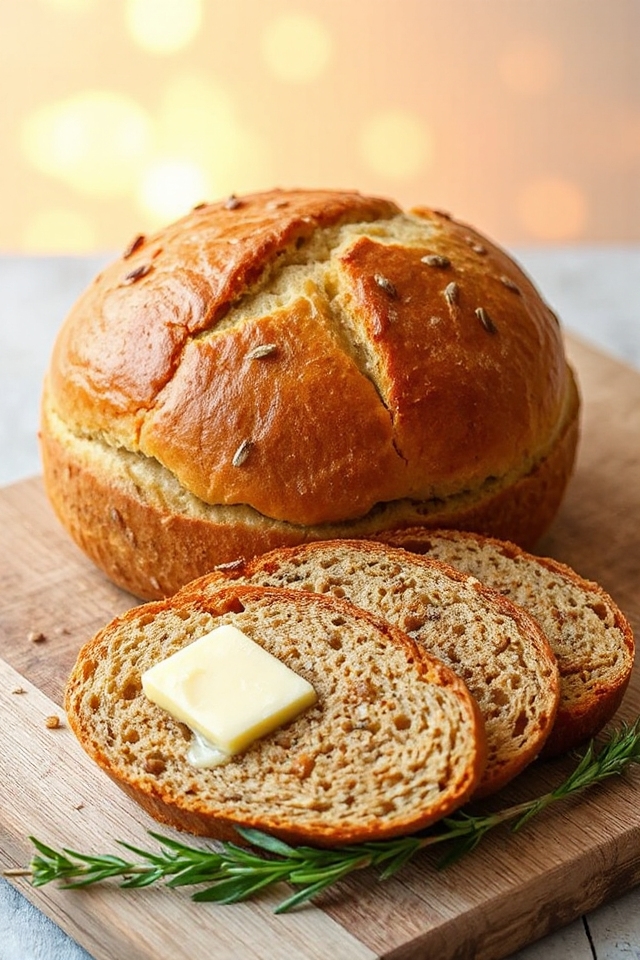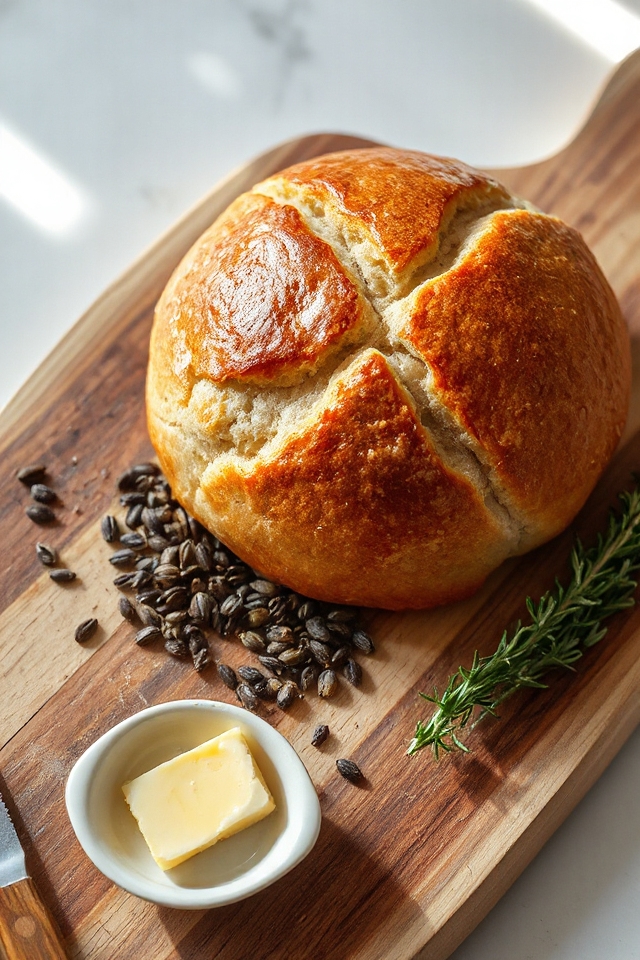Why You’ll Love This Buckwheat Bread Recipe
If you’re looking for a wholesome bread that’s both nutritious and delicious, you’ll love this buckwheat bread recipe. I’ve found it to be a perfect blend of hearty flavors and health benefits.
Buckwheat is gluten-free, making it a great option for those with gluten sensitivities. Plus, it’s packed with protein and fiber, keeping you satisfied longer.
The unique taste of buckwheat, combined with the subtle notes of caraway seeds, creates an inviting aroma that fills your kitchen.
I can’t wait to share this recipe with you; it’s sure to become a favorite in your home, just like it’s in mine!
Ingredients of Buckwheat Bread
When it comes to baking, having the right ingredients is key to a successful recipe. Buckwheat bread is no exception. With its unique flavor and nutritious profile, gathering these ingredients is the first step to creating a loaf that’ll fill your kitchen with warmth and good vibes.
Plus, it’s always a pleasure to see what goes into the food we eat, right? So, let’s explore what you’ll need to whip up this delicious buckwheat bread.
Here’s a list of the ingredients you’ll need:
- 1 (1/4 ounce) envelope of yeast
- 2 eggs, slightly beaten
- 2 cups lukewarm water
- 2 cups buckwheat flour
- 1 tablespoon light brown sugar
- 2 cups whole wheat flour
- 3/4 cup buttermilk
- 1 teaspoon salt
- 1 tablespoon caraway seeds
- 1 cup all-purpose flour
Now that you have your shopping list, let’s talk about a few considerations regarding these ingredients.
First off, if you’re new to baking with buckwheat, you might be surprised by its slightly nutty flavor—it’s definitely a departure from traditional wheat bread.
Also, make sure your yeast is fresh and active; nothing is worse than waiting for your dough to rise only to find out your yeast had a party and didn’t invite anyone.
And remember, the buttermilk not only adds moisture but also a slight tang that balances the flavors beautifully. If you don’t have buttermilk on hand, you can make a quick substitute by mixing regular milk with a splash of lemon juice or vinegar.
Now you’re ready to get baking!
How to Make Buckwheat Bread

Making buckwheat bread is a delightful journey that starts with a little patience and a sprinkle of love. First off, you’ll want to grab that 1 (1/4 ounce) envelope of yeast and proof it in 2 cups of lukewarm water mixed with 1 tablespoon of light brown sugar. This is where the magic begins.
Let it sit for about 5-10 minutes until it gets all frothy and bubbly—if it doesn’t, well, we might’ve a yeast party foul on our hands. Once you see that lovely yeast sponge, it’s time to mix in the 3/4 cup of buttermilk, 2 slightly beaten eggs, and 1 teaspoon of salt.
Now, the fun part—add in the 2 cups of buckwheat flour, 2 cups of whole wheat flour, and 1 cup of all-purpose flour, along with 1 tablespoon of caraway seeds for that extra flavor kick.
Once everything is in the bowl, mix it up until it’s well combined. Don’t be afraid to get your hands a little messy—dough is like a toddler; it just wants to play.
When the dough comes together, transfer it to a lightly floured surface and knead it until it’s smooth and elastic. This is where you can really work out any frustrations from your day.
Then, place the dough in a large buttered bowl, cover it with a towel, and let it rise in a warm spot until it doubles in size. This can take anywhere from 1 to 2 hours, so maybe take that time to watch a couple of episodes of your favorite show or, you know, just stare at your dough waiting for it to grow.
After the dough has risen, it’s time to punch it down a few times—yes, punch it down. This is oddly satisfying and helps release any air bubbles.
Next, shape the dough into a loaf and place it in a buttered 9×5 loaf pan. Cover it with a towel again and let it rise for another hour. Preheat your oven to 400 degrees while you wait, and when that dough has puffed up nicely, brush the top with a bit of melted butter.
Pop it in the oven and let it bake for about 30 minutes, or until it’s golden brown and sounds hollow when you tap it. Once it’s out, let it cool wrapped in a towel to keep it warm and cozy.
Trust me, the scent of freshly baked buckwheat bread will have everyone flocking to your kitchen like moths to a flame. Enjoy a slice—maybe with some butter, or just plain—because you’ve earned it.
Buckwheat Bread Substitutions & Variations
While you might be set on the classic buckwheat bread recipe, exploring substitutions and variations can add a personal touch to your baking.
For instance, I often swap in different flours like spelt or oat flour for unique flavors. You could also substitute honey for brown sugar or add seeds like sunflower or pumpkin for extra crunch.
If you’re dairy-free, almond milk works well instead of buttermilk. Experimenting with herbs, like rosemary or thyme, can elevate the taste, too.
Don’t hesitate to adjust the spices to suit your palate—each tweak can turn a simple loaf into a delightful creation!
Additional Tips & Notes
A few simple tips can elevate your buckwheat bread baking experience. First, make sure your yeast is fresh; it can make all the difference.
I also recommend using room temperature buttermilk for better incorporation. When kneading, don’t rush—take your time to achieve a smooth dough.
If you’re unsure about the dough rising, look for it to double in size. After baking, let the bread cool wrapped in a towel; it keeps the crust soft.
Finally, feel free to experiment with additional spices or seeds to customize the flavor. Happy baking! You’re going to love this bread!
